|
In This Issue...
 |
Drakes, Drakes, and More Drakes! |
 |
Drakes are worth it |
 |
Too many Drakes |
 |
Get to know your predators:
Fisher Cat |
 |
All about Runner Ducks |
 |
Recommended Reading:
One Duck Stuck |
 |
Reader Poll #7
|
|
Get to Know
Your Predators: The Fisher Cat
We have received a number
of emails from folks all over New England regarding
sightings of this predator, so we decided to make them
our predator of the month. Thank you, everyone, and keep
those emails coming!
A female Fisher Cat tends
to weigh around eight pounds and males around twelve
pounds. The Fisher Cat is a ferocious nocturnal
predator. They will kill anything they can overtake.
Fisher cats are very fast and extremely agile. They can
elongate their bodies and squeeze into small holes and
gaps.
These solitary predators are designed by
nature to climb over, dig under and gnaw through
obstacles, so be very wary of them. Locally we have
heard of one animal breaking into a turkey farm and
wiping out dozens of birds during a bloodthirsty
rampage.
Your best defense
against this predator is a tight daytime enclosure and a
well built nighttime lock up. Remember these predators
are designed by nature to squeeze into holes; be sure
your waterfowl enclosures don’t allow for this type of
entry.
The Month in
Photos
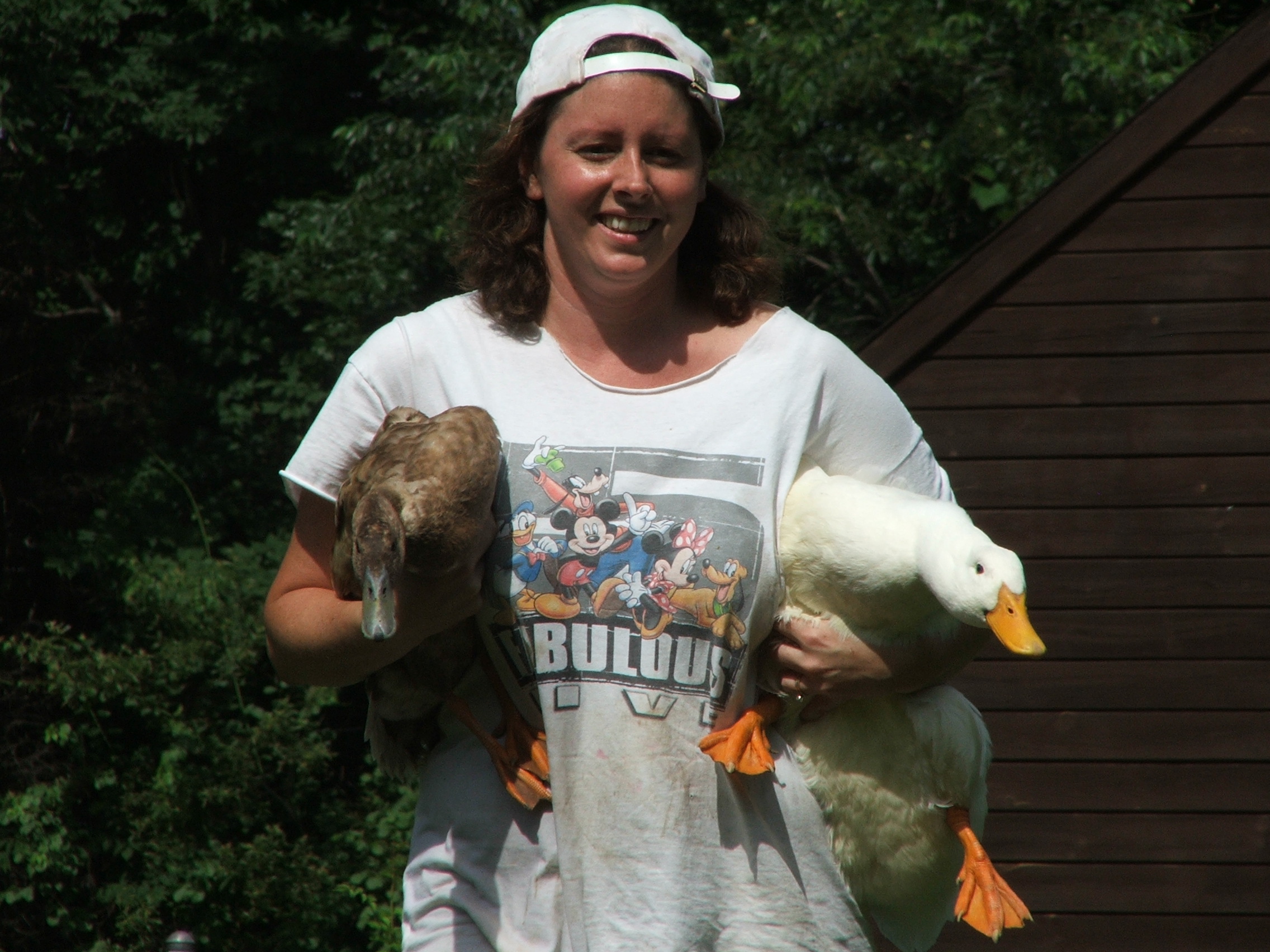
Kim with Jake & Elijah in arm
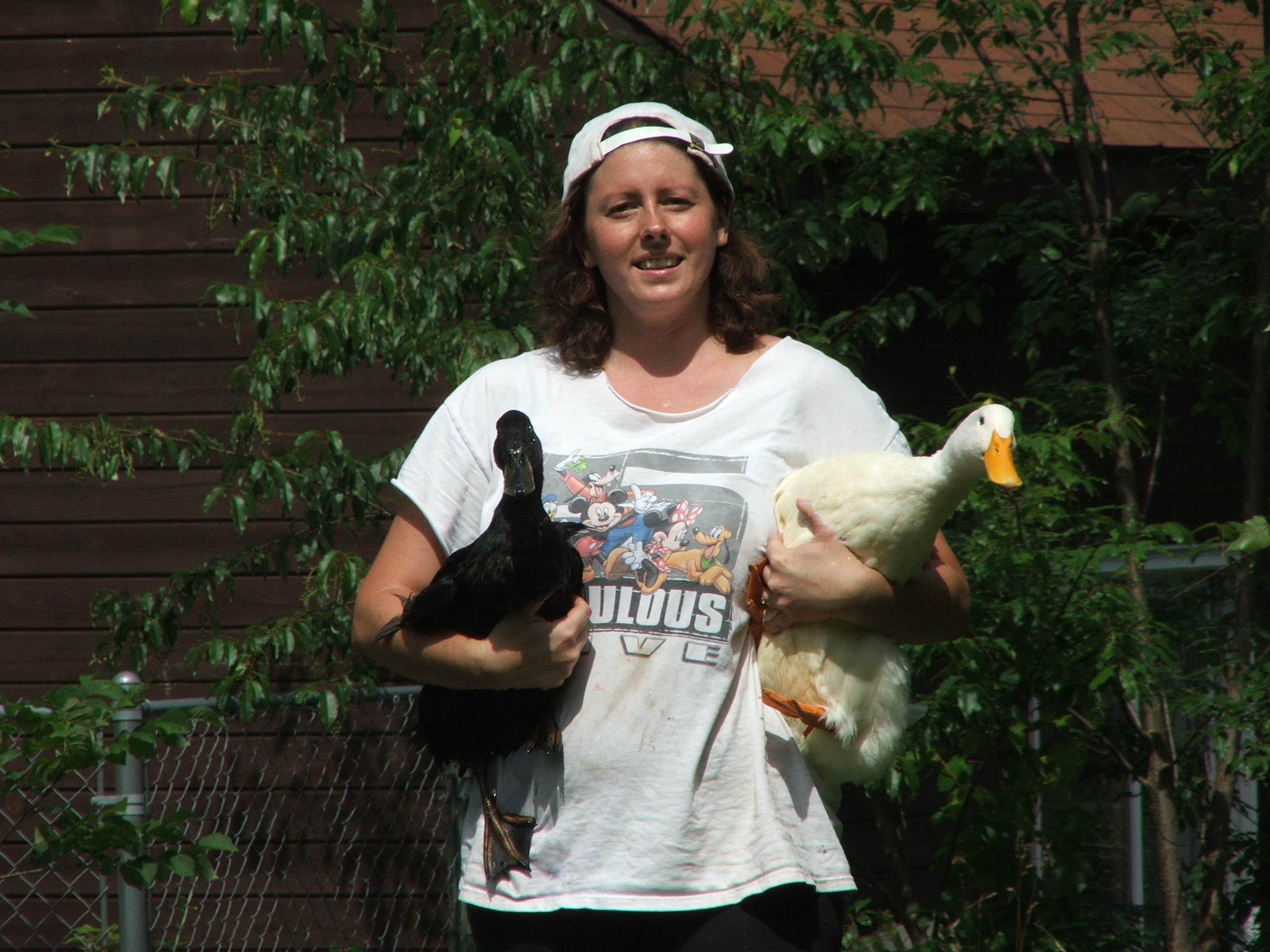
Kim with Winston & Mr. Pearl
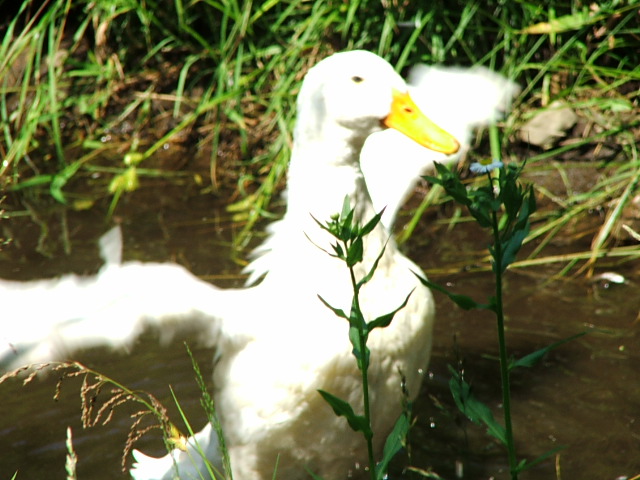
Joven on the pond!
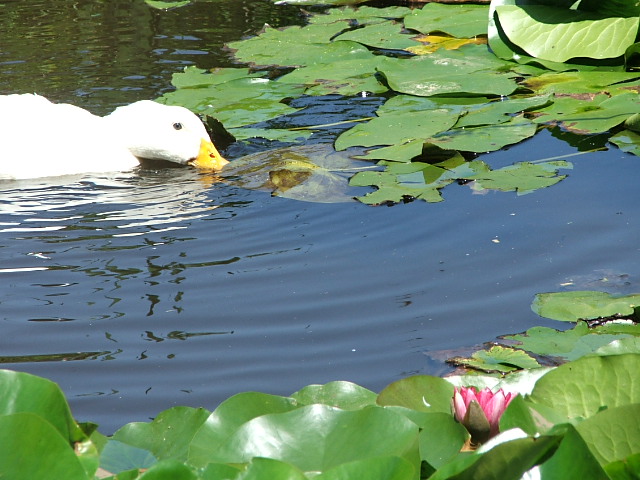
Playing in the lily pads...
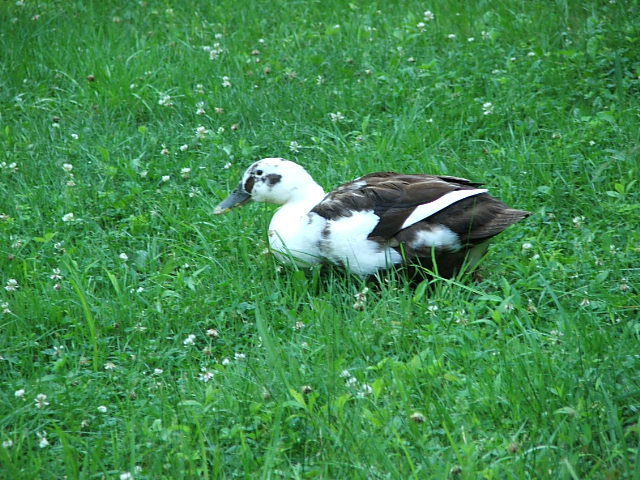
Vida in the grass
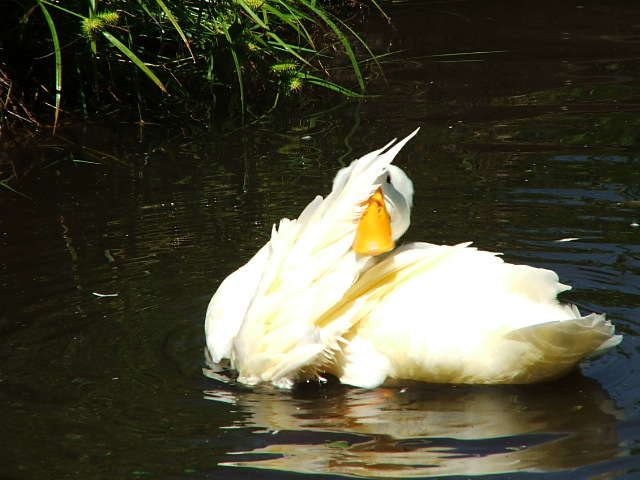
Peek-a-boo, Mr. Pearl!
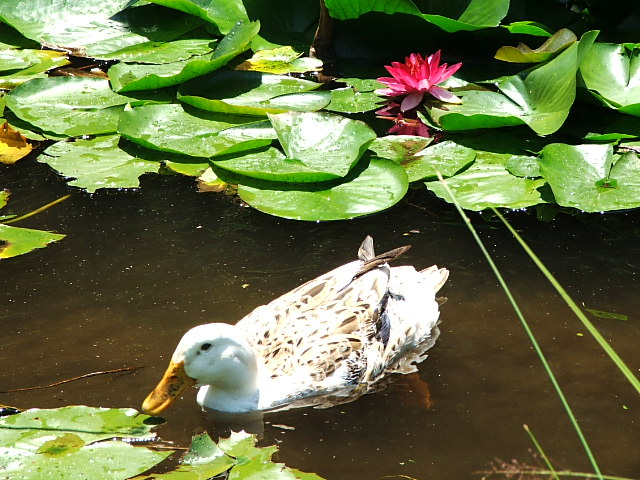
Jezebel and a pink lily flower
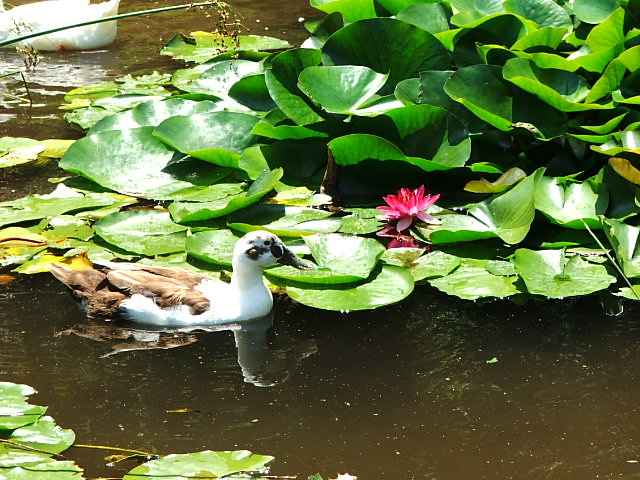
Vida and a pink lily flower
Recommended
Reading
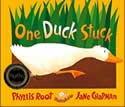
|
Ordering
information |
One Duck Stuck
By Phyllis Root
Illustrated by Jane Chapman
Description
"Splish, clomp, pleep,
plop, plunk, sloosh, slosh, slink, zing." Who can resist a
read-aloud featuring sounds like these? When, "Down by the
marsh, by the sleepy, slimy marsh, one duck gets stuck in
the muck," who comes to the rescue? Two fish, splishing, for
starters. Then three moose clomping, four crickets pleeping,
and so on. Still, "No luck. Still stuck." It takes a whole
lot of teamwork to get this particular stuck duck unstuck
from the muck, but this cheerful bunch is definitely up to
the task.
From one duck to 10
dragonflies, the muddy fun never stops in Phyllis Root's
chunky little board book. Young readers will giggle their
way through the numbers, and by the time the duck's foot is
released with a "Spluck!" counting will be a cinch. Jane
Chapman's lush illustrations are full of marshy colors and
muddy detail. The right side of each two-page spread shows
the hapless duck earnestly waiting for liberation by its
lively rescuers, while on the opposite side the featured
number is printed, large and bold, over the text, and the
splishers and ploppers are depicted again for easy counting.
Reader Poll #7
Question: If you had
the space, would you want multiple drakes in your flock?
Results of Reader
Poll #6 If you
determined that some wild ducklings or goslings you found
were orphaned, what would you do? (Be honest!)
Contact Us
Majestic Waterfowl
Sanctuary
17 Barker Road
Lebanon, CT 06249
directorATmajesticwaterfowl.org
Our Newsletter
The Majestic Monthly is published 12 times per year. Back
issues can be obtained online from our
Newsletter Archives.
|
|
Drakes,
Drakes, and More Drakes!
Managing
a waterfowl flock with multiple drakes is not always easy,
especially in the spring and summer when hormone levels are
elevated. However, it is extremely rewarding to have more than one
drake in your flock and experience a whole new level of group
dynamics. The question many people have is how they can protect
their drakes from one another and whether or not their hens will
need protecting from their drakes.
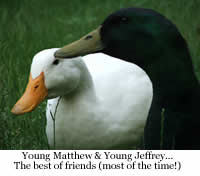
We have heard a few
folks claim that they simply allow their drakes to duel things out
without owner interference, but we have received many more emails
regarding drakes and hens that have been seriously injured or even
killed during these battles for alpha leadership. These devastating
mishaps are entirely preventable if you know the signs to watch for
and how to properly manage your flock when they become evident. The
myth that drakes do not make ideal pets or that multiple drakes
cannot be housed together is simply untrue. The situation only need
be handled responsibly and with a keen eye.
There are definitely
some guidelines to consider before welcoming a drake or multiple
drakes into your flock—or even a hen for that matter, but with a
little forethought and planning, drakes do make a wonderful addition
to your family.
- Provide a
healthy ratio of drakes to hens in your flock. Most sources
recommend at least a 1 drake to 4 hen ratio in order to avoid
excessive drake fighting or the over-mating of hens. Hens that
experience over-mating are prone to injury of the legs and hips
and also can be in risk of oviduct prolapse (where their egg
laying tube inverts and comes outside of their body).
- It is highly
recommendable to have hens that are equal to or larger than your
drakes. In fact, this can be one of the best gifts you give your
hen—an equal or smaller sized drake. This gives her the upper
hand, so she can thwart off any unwanted advances.
If your flock has access to water, too many drakes (or oversized
drakes in comparison with hens) can result in hen drowning.
Never allow drakes to battle over a hen during mating,
especially on water. The interrupting drake will often vent his
frustration on the hen rather than on the mating drake. A hen is
not always successful at pulling her head above water when two
drakes are holding it beneath the surface. If one drake is
trying to mate with a hen and a second drake swims over to
interrupt, it may become quickly necessary for you to step in
and break things up. We have a ten foot extendable pole on hand
that can safely nudge an extra drake out of the way.
If you are seeing irritated bald spots on the backs of your
hens’ necks, too many attempts at mating is usually the cause.
Their neck should be rinsed with warm water (no soap!) and kept
clean since the drake’s saliva can cause irritation. The hen
should then be separated to allow feathers to re-grow.
- Spacious pens
are a very good means at maintaining group harmony. Cramped
spaces tend to foster misbehavior and territoriality, so
consider carefully how many birds can comfortably fit into your
barn and enclosures before adding new members.
- Whenever
possible, introduce new flock members in the fall when hormone
levels are at their lowest. The fall is usually a time of peace
amongst flock members; however, be careful that they don’t
mislead you into believing that it will always be this
harmonious. Many an owner has bragged about how well their
drakes get along during their first year, and we don’t often
have the heart to tell them that things may not be so peaceful
next spring. It is commonly believed that drakes won’t fight if
they are without hens. Although there does seem to be less to
fight about, drakes imprinted on humans will often consider YOU
to be their “hen.” In this scenario, drakes may fight among
themselves over you, although this tends to only occur while you
are around and is easily monitored and kept under control
because you are always present during any outbreaks.
All introductions should be carefully monitored, especially if
they are not happening during the fall (low hormone season) to
ensure flock member’s safety. We highly recommend you keep a
close eye on pecking order disputes that arise between any of
your flock members at any time. It is completely normal to see
temporary squabbling among members as pecking orders are
established and reaffirmed. The introduction of any bird, drake
or hen, can cause the entire flock to suddenly have to rehash
things out. We consider “excessive” fighting to exist if the
squabbles appear to be getting too rough (evident by tufts of
feathers on the ground or in someone’s bill), too frequent, or
does not subside. When these conditions exist, separations are
definitely in order to avoid injury to any of your birds.
- To stop fighting
among your drakes, three good options are available to you:
- Separate
your drakes from one another, and divvy up the hens between
them (we try to keep pairs or groups that prefer one
another’s company together).
- Separate
drakes from hens; that is, drakes in one pen, hens in
another. This is a better choice when you can see that your
hens could use a break as well. Drakes tend to fight less
when they cannot mate with the hens. Often times, drakes can
reside together with minimal fighting on one side of a fence
with the hens in full view on the other. This is not always
the case, however.
- Separate
your drakes from one another, and separate your hens from
the drakes (the hens can all stay together). This becomes
necessary when the drakes simply cannot get along together
and all of the hens could use a break from the drakes.
Keep in mind that the
need for separations may vary from one day to the next, from morning
to evening, from hot to cold or dry to wet weather and as the
seasons change throughout the year. Your ducks and geese have
personalities, moods and feelings. Some conditions lead to
resentment among members, others to contentment. There are a number
of combinations of separations available to you and varying levels
of effectiveness depending on when they are used, so be careful not
to limit yourself to one remedy.
Drakes are Worth It
It
is so easy for us to find homes for hens. They tend to be adopted
out within weeks of arriving, but we have such a difficult time
placing the drakes. This causes an overabundance of drakes in many
animal shelters and sadly, often results in euthanasia. Majestic
Waterfowl Sanctuary will not euthanize any animal except to prevent
the needless & hopeless suffering of an animal.
Most people will
limit themselves to only one drake while others prefer to keep only
hens. Many people fear the safety of their hens with a drake around,
but drakes don’t have any intentions of hurting your hens. Although
the mating routine can be quite distressing to owners who have never
witnessed a drake forcing a hen’s head below the surface of the
water before, it is all quite normal and natural and owners’ fears
soon subside (provided that hens are not too small for their drakes
and there are no obstacles in the water for them to get trapped
under). Hens will often initiate courting just as frequently as
drakes, so you need not worry that they will be taken advantage of.
Having a drake in
your flock opens owners up to experience a whole new world of duck
behavior. Courtship consists of a wide new array of shameless
quacking, head bobbing, flirting and bathing. The interrelationships
among all members are heightened and your ducks live more enriched
and normal lives.
Multiple drakes are a
very viable option provided you prepare ahead of time. As long as
you have the means to separate them when times get touchy
and don’t mind some extra time and effort on your part they are
great fun. Nature has provided a few helping factors:
- Drakes tend to
fight less fiercely and less frequently if they have been raised
from ducklings together.
- Many drakes get
along wonderfully from Sept-Dec.
- As drakes age,
fighting tends to wane off between them. This often occurs by
their third spring.
The only word of
caution regarding multiple drakes is to consider your housing
situation before you take them in and weigh whether or not you can
accommodate separations. If you can run a three-foot high length of
poultry wire through your enclosure and easily divide it spaciously
in half, you can successfully care for more than one drake.

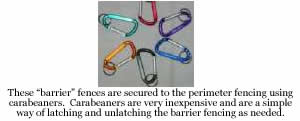
Elijah and Jake reside on the left side of the enclosure. Elijah is so
big, that Jake doesn’t even try to upset the status quo. The pecking
order was instantly established and honored without conflict.
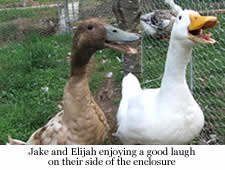
Three hens,
Jezebel, Deirdre and Vida reside in the middle of the enclosure.
Young Jeffrey and Young Matthew reside on the right end of the
enclosure. Having the hens occupying the pen between the two groups
of drakes prevents the boys from trying
to fight through a shared fence. Proximity to the hens provides
contentment for the drakes on both sides of the fence.
Jeffrey & Matthew were raised together as ducklings. They are three
years old and barely squabble any more.
Ending Up with Too Many
Drakes
This
topic brings up an important point of preventative maintenance for
anyone considering allowing their hens to hatch out a clutch of
eggs. Imagine that every egg your hen is sitting on were to hatch
out a drake. Do you have the means to separate and protect them all
from one another next spring? If not, you will have a serious
problem on your hands next spring. Please do not allow eggs to hatch
out animals that will later be homeless.
For anyone thinking
that the eggs their hens are sitting on are infertile, I advise that
you call any waterfowl rescue shelter or farm sanctuary and ask how
many ducks/geese have come into their shelter because their owners
didn’t think the eggs would hatch or because they didn’t make an
effort to find and remove eggs.
I am often reminded
of the line in Jurassic Park: “Nature finds a way.”
If you do not have
room for more ducks, search out eggs and remove them. This small
effort does wonders for the homeless domestic waterfowl population.
|